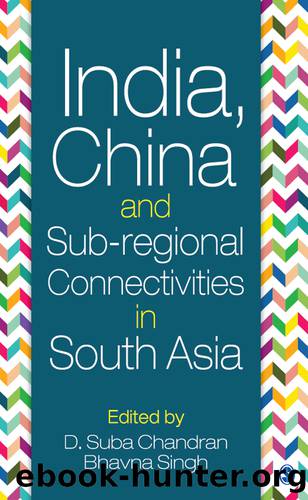India, China and Sub-Regional Connectivities in South Asia by Chandran D. Suba;Singh Bhavna;

Author:Chandran, D. Suba;Singh, Bhavna;
Language: eng
Format: epub
Publisher: SAGE Publications India Pvt, Ltd.
* * *
1 Arobinda Devidutta Mahapatra, âRussia and India Reportâ, cited on 1 June 2012, China Daily.
2 Ananth Krishnan, 25 February 2012, The Hindu (e-edition).
3 Primary Questions:
1 Since how long has trade been going on in this region? What is the history? Are the traditional trade routes still used? What were the goods traded then and what are the goods traded now?
2 Do you have any remnants of Silk Route? (local organizations)
3 Do both the communities belong to the same religion? Would you also like if the pilgrims get a free access to the areas of pilgrimage in both the countries?
4 Do the goods usually come from Nepal or Bhutan or directly from China?
5 Are there any restrictions on goods tradedâgovernmental or non-governmental? How do you suggest it should be done away with?
6 How is your relation with the people on the other side of the border?
7 Do you have good roads and transport system to transport your items?
8 Are you more dependent on the goods from the other side or are they more dependent on you?
9 (Question to key leaders) Are the relations between India and Bhutan or Nepal and India and China affecting the trade relations between the border towns? What can be done to improve the relation with India? Will it enable to expand the trade between the two countries?
10 How much is the volume of formal trade and how much is the volume of informal trade? List the items for formal trade and also that of informal trade.
11 (Question to the organizations and institutions) How can informal trade be formalized?
12 (Question to the organizations) Do you think opening of the trade and expansion will lead to territorial issues and conflict? How?
13 Would you like that the trade should be expanded?
14 The ethnic composition of the border town. The local issues and the historical background of the region. Nationalist movements or other such uprisings. Their view of the government at the state as well as the centre.
15 Region's topography and populationâthe demographic composition.
16 Role of organizations/institutions/local communities in economic activities of the region.
17 List out the economic activities of the region.
4 The Silk Routes (collectively known as the âSilk Roadâ) were important paths for cultural, commercial and technological exchange between traders, merchants, pilgrims, missionaries, soldiers, nomads and urban dwellers from Ancient China, Ancient India, Ancient Tibet, Persia and Mediterranean countries for almost 3,000 years. It gets its name from the lucrative Chinese silk trade, which began during the Han dynasty (206 BCEâ220 CE). Extending 4,000 miles, the routes enabled people to transport goods, especially luxuries such as slaves, silk, satin and other fine fabrics, musk, other perfumes, spices, medicines, jewels and glassware, as well as serving as a conduit for the spread of knowledge, ideas, cultures and diseases between different parts of the world (Ancient China, Ancient India [Indus Valley, now Pakistan], Asia Minor and the Mediterranean). Trade on the Silk Road was a significant factor in the development of the great civilizations of China, India, Egypt, Persia, Arabia and Rome and, in several respects, helped lay the foundations for the modern world.
Download
This site does not store any files on its server. We only index and link to content provided by other sites. Please contact the content providers to delete copyright contents if any and email us, we'll remove relevant links or contents immediately.
Adding Value to Policy Analysis and Advice by Claudia Scott; Karen Baehler(452)
Sociological Perspectives of Health and Illness by Constantinos N. Phellas(444)
Race and American Political Development by unknow(441)
Human and Global Security : An Exploration of Terms by Peter Stoett(423)
American Government and Politics Today by Steffen W. Schmidt Mack C. Shelley Barbara A. Bardes(422)
Control Of Oil - Hardback by Kayal(406)
Entrepreneurship Education and Training: The Issue of Effectiveness by Colette Henry Frances Hill Claire Leitch(358)
The Catholic Church and European State Formation, AD 1000-1500 by Jørgen Møller(354)
Materializing the Middle Passage by Jane Webster;(344)
The World According to China by Elizabeth C. Economy(340)
Left Is Not Woke by Susan Neiman(327)
Theories of Counseling and Psychotherapy: A Case Approach by Nancy L. Murdock(313)
Turkey's Relations with the West and the Turkic Republics: The Rise and Fall of the Turkish Model by Idris Bal(311)
Cross-Cultural Child Development for Social Workers by Lena Robinson(304)
Japan's Ainu Minority in Tokyo by Mark K. Watson(297)
Advances in Child Development and Behavior, Volume 37 by Patricia J. Bauer(294)
Laboratory Life by Bruno Latour(293)
Beyond Service: State Workers, Public Policy, and the Prospects for Democratic Administration by Greg McElligott(284)
The Oxford Handbook of Museum Archaeology by Stevenson Alice;(273)
